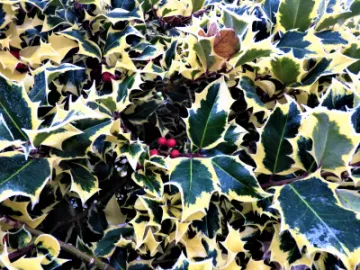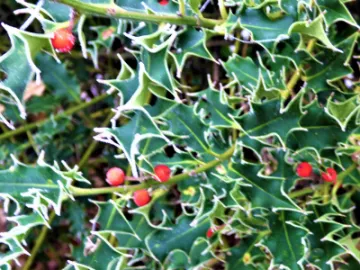







The Holly and the Ivy by Adrian Leighton
It is good to see that among the sparkly plastic Christmas decorations, the honest to goodness old holly and ivy still hold their place. Of course they have a very long tradition even before their association with the Christian festival. It is probably the carol, named after them, that has set their place firmly in the Christmas culture of this part of the world. The carol itself uses different parts of the plant as symbols of Christian truth about the birth and death of Jesus Christ. In fact whilst mentioning the Ivy in the first line the rest of the carol focuses on the Holly. However, there is another traditional song called "The Contest of Holly and Ivy" which uses both as contrasting male and female symbols. The carol which reaches back to medieval times was standardised by, the folk-song collector, Cecil Sharp, in his collection in the early 20th century

But what of these plants in real life? Perhaps Holly is that to which we relate more readily. Holly , or Ilex, has over 500 related species in its genus. It is Ilex Aquifolium, or common European Holly with which we are most familiar. The red berries, green leaved tree or bush has a striking appearance although, in their way, the variant yellow and even darker berried and variegated coloured leaf also have a commanding appearance. The use of holly as a decorative feature goes back to pre-Christian times when it was used in pagan rituals during Saturnalia, and was readily adapted by early Christians and has continued so to the present day.
Its herbal use has been confined to a type of tea used as a heart stimulant and in stronger form as an emetic. The red berries are toxic containing theobromine, saponin and colorants such as ilixanthin and rutin, to people and animals, although not fatally so for people. The other obvious feature is the spiky leaves. These are generally sharper on the lower branches to prevent browsing animals. Birds however share a symbiotic relationship with Holly – feeding on the berries and at the same time spread the seeds.

All in all, Holly is a well defended plant! Best admired and handled with care.
So what can we say about Ivy, Hedera helix? It is not everyone's favourite plant. Its habit of climbing trees has ecological contrasting effects. Positively, it is a superb companion for other wildlife from insects to birds providing nesting sites , protective cover and an abundance of later summer nectar for bees etc.
Negatively, it can smother the host tree to the extent that, Ivy being an evergreen, it becomes top heavy especially in windy winter months. Contrary to some popular belief it is not parasitic, it does not penetrate the tree's vascular system but clings to the trunk and branches.
Ivy on trees is a way of giving direction. The young shots begin on the side away from the sun and wind, usually on the damper North side and the leaves have more edges to absorb moisture. It reaches a point of adulthood when it move round to the sunny-side in order to catch more sun for photosynthesis. This, for us, will be the Southerly side, So to find South. even on a dull day, look for the ivy.
Its decorative features goes back to Roman times when it was associated with the festival of Bacchus, god of revelry and good times. In ancient Greece it was regarded as a fertility symbol and presented to newlyweds. Today it is still regarded as a holiday decoration.
It has had various medicinal uses including for respiratory conditions and is still included in some cough remedies today. It does however contain the toxic substance saporin which while not causing fatality can cause an upset stomach.
So when you sing about the holly and the ivy this Christmas, give a thought to its long and extensive association to human culture, life, and faith, as well as their significant place in the ecological life around us.
Get In Touch
AudlemOnline is powered by our active community.
Please send us your news and views using the button below:
Email: editor@audlem.org




